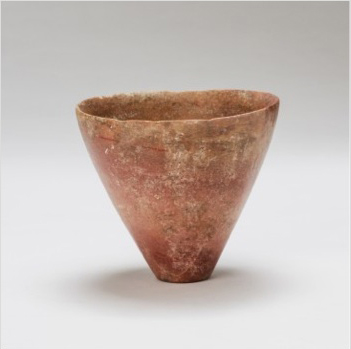Product Description
Christopher Dresser / James Couper & Sons Rare Clutha vase c. 1890


CHRISTOPHER DRESSER (1834-1904) UK
JAMES COUPER & SONS Glasgow, Scotland
“Clutha” vase c. 1890
Blown strawberry glass
This Dresser form appears as Linthorpe Pottery model no. 114.
Illustrated: Truth, Beauty, Power: Dr. Christopher Dresser 1834-1904,exhib. cat. Historical Design, Inc. (New York, 1998) p. 70.
Rare model.
H: 5 1/8” x W: 6”
Christopher Dresser / James Couper & Sons Rare Clutha vase c. 1890
ANDRÉ THURET (1898-1965) France
“Organic” vase/bowl c. 1930
Handblown and formed clear glass with bubble technique encapsulating a frosty white oxide.
Signed: ANDRÉ THURET
H: 2 3/8″ x D: 4″ x W: 6 1/4″
Andre Thuret was one of the first modern French studio glass artists and a contemporary of Maurice Marinot. He was born on November 3, 1898 in Paris. It is by science that Andre Thuret came to art. It is in Thuret the engineer and the chemist who serve Thuret the vase artist. The scientist places at the disposal of the creator of forms, rates/rhythms and colors the fluid and transparent beauty of glass and the reactions of metallic oxides. He worked in a traditional glass blowing technique at a temperature often exceeding 1,000 degrees. Thuret exhibited at the Salon d’Automne in 1928 and 1932 and obtained his first plate of the Company of Encouragement to Art. He was invited to exhibit in the United States in 1929-1930. Andre Thuret received his Chevalier of the Legion of Honor in 1947.
CHRISTIAN THOMSEN (1860-1921) Denmark
ROYAL COPENHAGEN
“Frog and Dragonfly” vase 1901
Glazed porcelain with a frog in 3-D sculptural relief looking at a dragonfly seated on a calla lily leaf looking up at the blossom.
Form number 280
Marks: ROYAL COPENHAGEN, CROWN, 465/250, 3 wavy lines (Royal Copenhagen) insignia, inscribed A. 250
For more information see: Musterbuch KPF, um 1930, Illustration number 204; Porzellan, Kunst und Design 1889 bis 1939, vom Jugendstil zum Funktionalismus (Berlin: Bröhan-Museum, 1993) p. 467, ill. 435; Sammlung Bröhan: Kunsthandwerk 2, Metall, Porzellan (Berlin: Bröhan Museum, 1977), pp. 222-285.
H: 9″ x Dia: 3 1/2″
Christian Thomsen was employed at the Royal Porcelain Manufactory (Royal Copenhagen) in 1898, and was employed there until his death in 1921. Thomsen is said to have had a huge impact on Royal Copenhagen’s success throughout the 20th century. A large part of the recognition by the Royal Porcelain Factory has enjoyed over the years, they can thank Christian Thomsen for. He produced more than 100 different figurines, especially he had a fondness for agricultural characters, children figurines, figurines inspired by Hans Christian Andersen’s fairy tales, fauns and trolls, and not least charming animals and bird figures.
